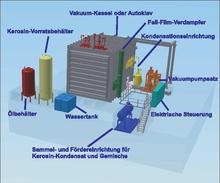Vapor phase drying
The vapor-phase drying ( English vapor-phase drying ) is today considered as the most effective and especially gentle process for the industrial drying of power transformers (3-phase transformers) of transducers and of large hollow rod insulators (engl. Bushings ) and transformer coil and other insulated high-voltage components and takes place under vacuum and using a solvent ( kerosene ). The process is used in production as well as for repairs and refilling with oil. There are stationary and mobile vapor-phase drying systems.
"Drying" means the cleaning of the insulating materials and materials ( transformer oil and cellulose- containing paper and press board ) from moisture and other impurities that can reduce the performance of the transformer or negatively affect it.
By using (flammable) kerosene, the entire system must be kept permanently under vacuum (oxygen exclusion) and ATEX explosion protection must be applied.
Function and principle
Vapor phase drying is a complex and multi-stage drying process and, in addition to removing moisture and oxygen, separates transformer oil by means of kerosene vapor (vapor phase) from the insulation of impregnated transformers. In general, the method is intended to produce or maintain the necessary dielectric properties of the insulation and thus the operational reliability of the transformer.
In series or in combination, the fully automatic work steps such as heating, evaporation, evacuation , distillation , separation and cooling take place.
The main work steps are described below:
After the material to be dried (transformer) has been brought into the drying chamber ( autoclave ), the system is evacuated using a pre-vacuum . The active transformer part, which weighs several tons, is heated by introducing hot kerosene vapor, which transfers the thermal energy and initially condenses until the target temperature is reached, thereby “washing out” the water and oil.
The mixture of kerosene, water and oil is discharged via separators and later cleaned and returned to the material cycle. When the target temperature or the boiling point of the water is reached, the vapors are extracted by vacuum, condensed and cleaned as described above. For this purpose, a fine vacuum down to 0.1 mbar is created in order to evacuate moisture trapped deep in the insulating layer.
The completely dried component can then be slowly cooled and ventilated. At the same time, the mixed liquids are processed again for new use and the system is ready for operation again.
The dried transformer is then placed in its housing and is promptly flooded with treated oil in order to avoid "re-moistening" by the environment. The drying and cycle time of the process depends on the total weight to be heated, the insulating layer and the water content and can take several days.
The main components of a vapor phase drying system are:
- Kerosene storage container
- Kerosene evaporation device ( falling film evaporator )
- Condensation device
- Vacuum pump set
- Vacuum vessel (autoclave)
- Collection and conveying device for kerosene condensate and mixtures
- Cooling water and compressed air monitoring
- Electric control
history
For around 100 years, paper has been used as high-voltage insulation, dried and then protected against rewetting.
Initially, paper was dried with hot air in closed chambers and later supported by fans and evacuation systems to increase its effectiveness (convection drying).
The use of kerosene as a solvent has been known since the Westinghouse system of 1950 and the vapor phase process has been continuously improved and developed since the 1970s. Initially, immersion tube evaporators as well as circulation and cascade evaporators were used. From 1995 thin-film evaporators (falling film evaporators) were used for further improvement.
Since 2003, compact expansion evaporators have also been used and used , especially for mobile vapor-phase drying systems.
Advantages over other processes (convection) are, for example, the higher drying temperature and very good and even heat transfer due to droplet and thin-film condensation. Intermediate pressure reductions in the drying process ensure efficient removal of water and kerosene from the insulation and enable shorter drying times as well as significant energy savings . Environmental protection is guaranteed through closed cycles and the prevention of oil contamination.
literature
- Josef Kindersberger (ed.): Diagnostics of electrical equipment. 1st edition. VDE-Verlag, Berlin / Offenbach 2004, ISBN 3-8007-2817-6 .
- Andreas Küchler: High voltage technology: Basics - Technology - Applications. 3rd edition, Springer, Berlin 2009, ISBN 978-3-540-78412-8 .
- H. Yoshida, T. Suzuki: Drying Process of Insulating Materials of Transformers . In: IEEE Transactions on Electrical Insulation . EI-20, No. 3 , 1985, pp. 609-618 , doi : 10.1109 / TEI.1985.348805 .
- Paul Koestinger, Erik Aronsen, Pierre Boss, Günter Rindlisbacher: Practical experience with the drying of power transformers in the field, applying the LFH technology . In: Report A2-205, CIGRE . 2004 ( PDF ).
- Ajay Bangar, Rajan Sharma, HPTripathi, Anand Bhanpurkar: Comparative Analysis of Moisture Removing Processes from Transformer which are Used to Increase its Efficiency . In: The Global Journal of Researches in Engineering A: Mechanical Mechanics Engineering . tape 12 , no. 5 , 2012, ISSN 0975-5861 ( PDF [accessed October 16, 2013]).
- ↑ Gill, Paul (2009). Electrical power equipment maintenance and testing (2nd ed. Ed.). Boca Raton: CRC Press. p. 193. ISBN 978-1-57444-656-2 .
- ^ Küchler, Rudolf (1966): The transformer basics for their calculation and construction. Springer Verlag Berlin. P. 295, doi : 10.1007 / 978-3-642-52496-7 .
Web links
- Stefan Zabeschek, Helmut Strzala: Drying of High Voltage Transformers in the Field with a mobile vapor phase drying equipment. (PDF, 1.7 MB) 2007, accessed on October 29, 2013 .

